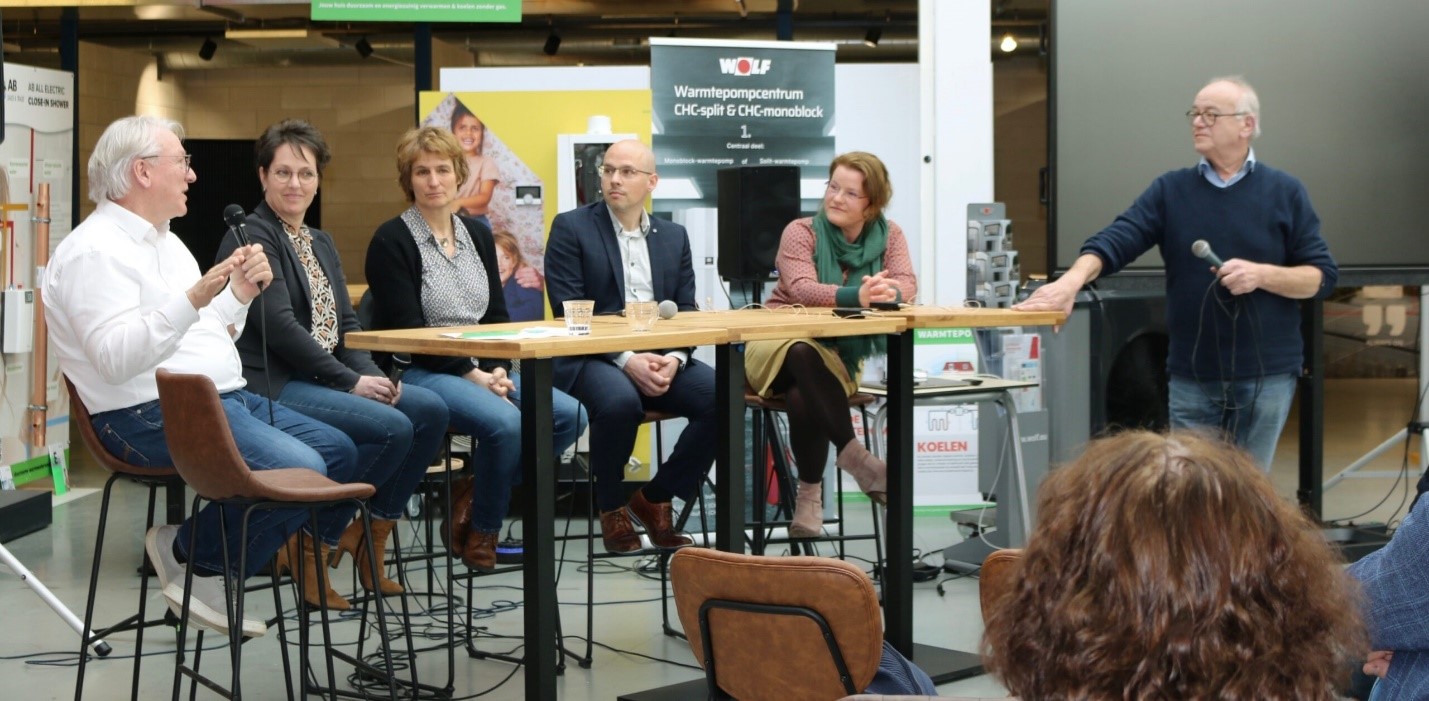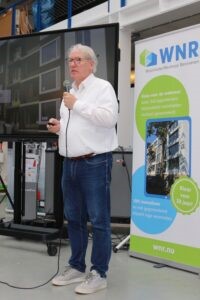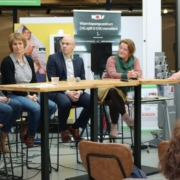Highlights from CondoReno’s first public Symposium

Factor 10 renovation
At the end of March 2023, “Factor 10 renovation for Condominium Associations (CAs)” was the focus of a symposium organised by Knowledge Institute KERN and WNR and partners within the EU project CondoReno. The participants of the event were from education, business, finance and government, diverse in other words. So are the issues surrounding the CA buildings over a wide range of facets. They are all transition problems and certainly solvable. This symposium was a profound reflection of the search for these solutions and also a prelude to CondoReno, an EU project to stimulate high-quality approaches in energy renovations of owner-occupied apartment buildings.
By Clarence Rose
CondoReno: optimisation of renovation processes for CAs required
Erwin Mlecnik, assistant professor TU Delft, opened the symposium with a summary of the obstacles to high-quality energy renovations by CAs. He also brought up CondoReno’s goals of managing deep energy renovations of CAs. Unburdening, trust and sufficient resources are keywords here, and the complex and often drawn-out decision processes of CAs require knowledge and commitment from the supervisors and from the CA boards. CondoReno will focus on activating CA demand and developing integrated market offers and support for successful decision-making among CAs. Interested parties are invited to participate in CondoReno and join local stakeholder groups. CondoReno is also setting up a national advisory board in Belgium and in the Netherlands with the aim of jointly paving the way for successful energy renovations by CAs.
Unburdening: making CA renovations easy
WNR is a foundation dedicated to facilitating integral housing cost-neutral renovations for CAs. Walter Steenis, director of WNR, talks about WNR’s role as a liaison between CAs, renovation partners and financiers. Unburdening CAs is about: good advice and process guidance, high-quality implementation with guarantees on building performance and financing that keeps the monthly costs for CA flat owners and residents equal. This is possible if the CA has sufficient maintenance reserves. But even if this is not the case, a full shell renovation in one go is often the most comfortable and financially attractive solution. Renovation converts high maintenance costs and high energy consumption into minimal costs for maintenance and energy use. The cost of the renovation is paid back through service charges.
Feasibility CA renovation starts with a thorough Multi-Year Maintenance Budget
Nevertheless, Van Steenis stresses the importance of a solid multi-year maintenance budget with full replacement cycles over the next 30 years. The “housekeeping book” must be in order. WNR is particularly focused on large apartment buildings from the 1960s to ’80s, but there is no hard limit there. WNR provides feasibility studies that do not overcharge CA residents: we create clarity on performance and feasibility and do not saddle laypeople with technical discussions. In the feasibility study, we calculate for an approach in which each euro invested in insulation and techniques has the greatest added value, looking over the entire lifespan.
Total renovation of CA flats – but socially minded
Despite the resulting low energy bills, home improvement with higher comfort and increase in the value of the home, there are sometimes residents who are not able to afford the extra service costs and are reluctant to invest to the advantageous total renovation. Cooperation with local government is crucial here – a safety net is needed for those who really can’t pay (if not, you can ask them still to pull out). We want to implement a social policy: those who live there should actually be able to stay there after renovation. There are already first examples of safety net schemes in the Netherlands, but they are not yet systematically embedded. Further steps would requires greater political effort.
Financing factor 10 renovations based on quality guarantee
 In principle, CAs are actually financially reliable partners and after a total renovation, energy costs are often minimal. With the building performance guarantees for the duration of a loan, WNR creates clarity about the financial space freed up by energy savings, thus relieving the funder. The latter can provide long-term loans that can cover the cost of a high-quality approach. But the rise in interest rates poses a threat to the renovation wave WNR envisages. Of course, it helps to improve renovation processes and work with prefab standard solutions. Capping could offer a solution, but is legally tricky. A contingency fund can help make resources available in case of a setback.
In principle, CAs are actually financially reliable partners and after a total renovation, energy costs are often minimal. With the building performance guarantees for the duration of a loan, WNR creates clarity about the financial space freed up by energy savings, thus relieving the funder. The latter can provide long-term loans that can cover the cost of a high-quality approach. But the rise in interest rates poses a threat to the renovation wave WNR envisages. Of course, it helps to improve renovation processes and work with prefab standard solutions. Capping could offer a solution, but is legally tricky. A contingency fund can help make resources available in case of a setback.
“Factor 10 renovation really works” – Carl-peter Goossen at CondoReno symposium
Successful Factor 10 renovations
It really works! With factor 10 renovations, you make renovations easily affordable and you can work with peace of mind with quality assurance. Carl-peter Goossen of Bouwnext and lecturer at Knowledge Institute KERN can show a whole scope of successful factor 10-renovation projects as a consultant. Some examples are CA of Ellen Assen as the first pilot for a housing cost-neutral approach, Nolensstraat Wageningen and renovation Sint Michelsgestel.
He gained experience with smaller renovation projects. Energy demand forecasting with the Passive House Planning Package (PHPP) came out perfectly there. So it works just as well with apartment buildings. He shares his experiences, tips and lessons learned. Balanced ventilation with heat recovery is essential for a healthy indoor climate after renovation and for low energy bills. With easily available commercial diffusers, you can supply and extract air through a single wall outlet without significant air mixing, which is really convenient. You need to be careful in apartment buildings with floor system close to its end of life (e.g NeHoBo floors common in NL). As these are now mostly at the end of their structural life, demolition-new construction is often the preferred route.
In high-quality façade renovations, heating via the ventilation supply is usually sufficient. Then you only need radiators to comply with legislation or for emergencies. “I have never had to use the radiator” and “I pay 5 euros a month and get money back at the end of the year too!” are common comments from residents.
If you do it, do it right!
Step-by-step approaches are also possible. For example, within the EuroPHit project, this has been researched and strategies have been developed to make buildings highly energy efficient. To avoid lock-ins, it is important to set the dot on the horizon even before the first measure is taken. So first consider what the building should look like after the step-by-step approach, also in terms of energy performance. Then make a plan of the steps and order to get there. He also refers to the Future-proof standard and target values for renovation of Dutch housing stock. By adhering to these, you avoid having to redo a measure before end-of-life. If you do it, you do it well. It is also important to take the right sequence of measures and to match up the details. As soon as you replace window frames and glass, you also provide energy-efficient balanced ventilation. This prevents moisture problems and ensures a healthy indoor climate. And if you replace glass, make sure it is well-insulated and therefore triple-glazed with a high g-value so that the winter sun can contribute to warming up the building. Also, the heating system should match the energy demand; too much output leads to unnecessary heat loss. You can make the right choices for a specific project using a morphological diagram. This way, you avoid losing sight of issues and you can include laymen and all experts involved in the chosen approach.
Financing really doesn’t have to be a problem
The National Heat Fund was established by the Dutch central government in 2013 with the aim of accelerating the sustainability of the building stock. The fund has been jointly filled by various financiers and the national government and contains €1.2 billion. According to Fiona Hamberg, national account manager for CAs at the Warmtefonds, home comfort is also financial home comfort. Financial surprises can be overcome by a well-developed MYOB. Taking out loans can often be a convenient way for CAs to get started on sustainability quickly. In doing so, overdue maintenance can be solved immediately, even if there would not be enough money for that immediately. Saving up for a project later often does not receive sufficient support among CAs.
Financing from individual measures to total renovation
The fund can be spent on energy-saving measures or combinations thereof (up to €30,000 incl. necessary additional work, repayment period maximum 20 years).
The ‘Appartementsrecht’ in Dutch, is the juridical description of the transaction if you buy an apartment in a condominium. You don’t own the apartment in a juridical way, you actually own the right to use it. You do own a part of the whole building and it is the collective responsibility to maintain the building. This is regulated in the Civil Code Book 5, Title 9 and allows for building finance in CAs. Here, it is important to look at the subdivision deed that defines what is individual and what is collective ownership. The heat fund can also provide private energy savings loans, if, for example, the windows are the individual responsibility of the residents. But for a collective approach, the ‘Zeer energiezuinig pakket’ (up to €60,000 per flat) or ‘Zeer energiezuinig pakket plus’ (including the financing for addressing the heating system, up to €78,000 per flat) is available. This loan is only provided for a total renovation for the entire CA. Flat owners are liable for their fractional share. The loan is also possible for mixed ownership (up to 50%) with a landlord. The loan is available for CAs from 8 members upwards, the loan agreement is concluded with a notary and the repayment period is up to 30 years.
But there are also financing options for smaller CA including a safety net scheme.
Funding schemes for CA renovation, fine but sometimes tricky
The Heat Fund works with a nationally set interest rate. Some provinces and local governments opt for additional interest rate reductions to make this loan even more attractive for CAs. On the Heat Fund’s website, there is a quick scan to quickly clarify the possibilities for a CA.
Besides the energy savings loan, there are other financing options available. For CAs, it is sometimes difficult to go to different bodies and counters for this and to coordinate everything. There is room for improvement there.
Funding half-measures? Look at the bottom line!
The Heat Fund allows financing of smaller measures. But financing measures without an action plan for a future-proof building should be looked at critically. Even if these reduce energy costs, there is a chance that you will create lock-ins that will actually drive up costs for residents in the future. It is important to create a final picture for the owner-occupier association; the target values discussed earlier can also help. Often forgotten are the airtight connections, for example in roof renovations the transition to the facades. These are construction mistakes that we really need to be ahead of. According to Clarence Rose of the KERN Knowledge Institute, we should stay away from the low-hanging fruit. This is precisely what is needed to make future-proof building measures feasible. Once the low-hanging fruit is picked, high-quality energy renovation is often unaffordable.
Knowledge and quality are prerequisites for successful Factor-10 renovation
Knowledge institute KERN offers valuable training in this field, for designers, (professional) clients and executives who want to get on with making buildings energy efficient. Building performance guarantees pave the way for long-term and therefore affordable financing, and provide confidence in energy renovation. Quality in design and process are conditional here.
Factor 10 renovation is also of social importance
KERN stands for integral sustainability where energy transition does not compromise people’s quality of life and nature. The plans for “sustainable energy supply” require, according to studies by the Finnish geological institute GTK, impossible scaling up of mining worldwide. According to KERN, far-reaching energy conservation is needed to keep the energy transition socially acceptable. Factor 10 renovation according to the passive house standard often reduces heating needs by over 90%. With low energy needs in winter, this approach avoids capacity problems of sustainably generated energy in the winter months. So the Trias Energetica approach is also of social importance. But the passive house standard also ensures that our buildings remain livable in themselves, with a healthy indoor climate, comfortable and (also in the future) affordable.
Passive house standard prevents problems
Passive building and renovation is not complicated: You give the building a good coat of thermal insulation all around and make it airtight to prevent condensation in the insulation. You also provide energy-producing window frames and energy-efficient balanced ventilation. To prevent temperature overshoot, install external blinds on East and West. When renovating, you can’t change the orientation, but the winter sun on the south helps reduce the energy burden considerably. So if possible enlarge the windows on the south side. Et voilà, the energy requirement for heating is less than 25 kWh/m2 per year. The EnerPhit standard for renovation provides a quality assurance to achieve the intended energy ambition with a constructional correct design and quality in execution.
Especially in renovations, connection details are important. Thermal bridges and condensation can be prevented by a well-considered design. For this, check the temperature factor, which should be higher than 0.7 at window frame connections, for example. When dealing with interior insulation, appropriate ‘’double window’’ system are required to prevent condensation and preserve the historic window frame. This is a way to improve the energetic performance of traditional windows by putting an extra (double) window behind the original window

Example living cost-neutral factor 10 renovation CA-Nolensstraat Wageningen
Energy balance calculation and well-thought-out concept
The PHPP (nZEB tool) is a suitable calculation tool for properly weighing up the measures and sizing the installations. It also allows you to properly visualise a step-by-step approach to coordinate the intermediate steps and determine the final goal.
This also allows you to predict interim energy costs and determine total costs for financial planning. Sustainable building is expensive, but ‘business as usual’ is unaffordable. The passive house system was developed with affordability in mind. This includes total costs. And renovations at that level are also quite feasible, whether or not with long-term loan financing.
Reducing costs requires a streamlined process. To this end, KERN is working with WNR to optimise the renovation process for CAs. To begin with, the decision-making process shall run smoothly and the right consideration frameworks should be set. But also later when it comes to implementation, it is important that this can take place at a high quality so that the residents ultimately get what they were promised.
–The Dutch version of this Article and presentations of the event are available at the website of KERN–



